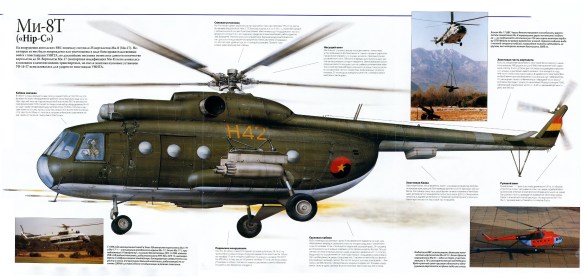In May 1960, Mil conceived a machine to replace the piston-engined Mi-4 Hound. On June 9, 1961, the first Mi-8 Hip prototype, with a single AI-24V turboshaft and four-bladed main rotor system, lifted off for its maiden flight. On September 17, 1962, the Hip B, modified with two TV2-117 1,482-horsepower turboshafts mounted atop the fuselage, and a five-bladed main rotor system measuring 70 feet in diameter, took flight. The Mi-8 went into full production in 1965, and by 2000 fifty-four countries operated the more than 10,000 Mi-8s manufactured by the Rostov and Kazan production facilities in Russia and by foreign licensees. Designed as a medium-lift transport helicopter, the Hip, in its many variants, fulfilled a miscellany of mission requirements, including troop and cargo transportation, air ambulance, attack helicopter, airborne command post, fire fighter, and civilian carrier.
Constructed of light alloys, the Hip featured a “bus-shaped” fuselage with a rounded nose and glassed-in cockpit that accommodated a pilot, copilot, and flight engineer. The cabin housed twenty-four passengers, 8,800 pounds of cargo, or twelve stretchers. A large sliding door on the forward port side and rear-opening clamshell doors simplified loading large cargo. Removable interior seats and an internal winch capable of lifting 350 pounds that doubled as a rescue hoist facilitated cargo handling. Additionally, Mil equipped the aircraft with a cargo hook capable of carrying slingloads up to 6,500 pounds. A long tailboom extended from the upper portion of the fuselage and swept up to a tapered vertical fin that housed the gearbox and tailrotor, attached to the left side (right on the export versions).
External racks attached along the center of the 61-foot fuselage were designed to hold auxiliary fuel pods or weapons systems. Variants of the Hip carried a combination of 57-mm or 80-mm rockets, AT-2 Swatter or AT-3 Sagger ATGMs, 12.7- or 23-mm gun pods, or either 4 500-pound or 2 1,000-pound bombs. In 1967, Mil introduced the Hip E and F ground support helicopters, each mounting a flexible 12.7-mm heavy machine gun under the nose and carrying 192 57-mm rockets. Combat troops could also fire their individual weapons from the windows of the helicopter. In later models Mil installed the upgraded Isotov TV2-117A engines, which produced 1,700 horsepower each. Generally a Hip cruised at 122 knots, had a service ceiling of 14,700 feet, and hovered Out of Ground Effect (OGE) at 2,600 feet. All Mi-8s rested on a fixed tricycle landing gear, with dual wheels at the nose. Total production estimates ran as high as 15,000 units of the Mi-8 and its export version, the Mi-17.
MIL MI-8 /MI-17 HIP C-K
Country of origin: USSR
Crew: Two pilots and flight engineer
Rotor diameter: 70 ft. Length: 61 ft.
Armament: Combinations of 12.7-mm machine gun in nose, SA-2 Swatter/ AT-3 Sagger ATGMs, 57- and 80- mm rocket pods, 23-mm cannon, and bombs
Powerplant: Two Klimov TV2-117AG (Mi-8)/ TV3-117MT (Mi-17) turboshafts
Airspeed: 135 knots
Range: 200 nautical miles (545 with auxiliary fuel)
Cargo capacity: Up to 32 combat troops, or 8,800 pounds’ internal cargo, or 6,614 pounds slingload
Notes: Designed to replace Mi-4, first flown in June 1961; used by Soviet and Russian forces and Aeroflot. Military versions denoted by round windows and armed with machine guns and 57-mm rockets. Later version designed and equipped for ECM operations. Introduced in August 1975, Mi-17 employed Mi-8 fuselage and Mi-14 engines; latest version with upgraded engines is Mi-17 Hip H. More than 10,000 of all variants manufactured and used by Armenia, Azerbaijan, Afghanistan, Algeria, Angola, Belarus, Bulgaria, Cambodia, the Commonwealth of Independent States, Croatia, Cuba, Czech Republic, Egypt, Germany, Guyana, Hungary, Iran, Iraq, Madagascar, Mongolia, Mozambique, Nicaragua, North Yemen, People’s Republic of China, Slovakia, South Yemen, Sudan, Syria, Ukraine, Vietnam, Yugoslavia, and Zambia.
